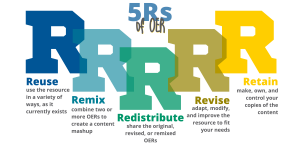What are OERs and Why Use Them?
Open Educational Resources (OERs) refer to any type of educational materials that are published under a public domain such as Creative Commons (CC) and General Public License GNU. This openly licensed content can come in the form of:
- Textbooks
- Videos
- Labs
- Courseware
Content under a CC license has 5 key points that can describe how it can be used:
- Reuse – Content can be reused in its unaltered original format
- Retain – Copies of content can be retained for personal archives or reference
- Revise – Content can be modified or altered to suit specific needs
- Remix – Content can be adapted with other similar content to create something new
- Redistribute – Content can be shared with anyone else in its original or altered format

There are a number of benefits associated with the use of OERs for both faculty and students. For faculty, using OERs can provide resources for little to no cost, have content custom made for their course, and while doing so spread and develop their professional career. For students, OERs are free, readily available, and can be used beyond the conclusion of the course.
Media Attributions
- 5Rs-7(transparent)

